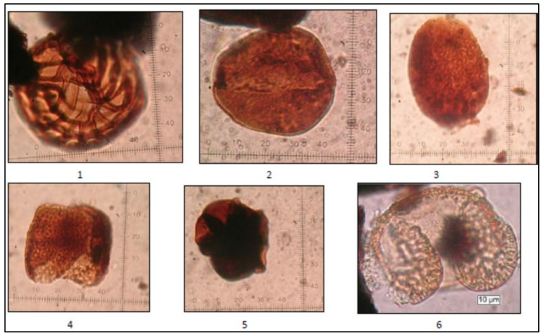Paleoenvironment of Tanjung Formation Barito Basin- Central Kalimantan Based on palynological data
DOI:
https://doi.org/10.24273/jgeet.2017.2.2.305Keywords:
Paleoenvironment, pollen, Tanjung Formation, Central KalimantanAbstract
The research area is located in the Muara Teweh, North Barito, Central Kalimantan. The cocking coal deposits are well known as they were produced from this area. Upper part of Tanjung Formation is target coal production. The study objectives are to analyze paleoenvironment and to determine the relative age of coal deposits based on palynological data. Preparing palinological analysis used standard procedure by hydrofluoric acid method.Palynomorphs data grouped into six types of ecology, and the sequence is as follows ; fresh water and lowland (41,75 %), brackish water swamp (30,10%), Peat and freshwater swamp (17,96%), marine element (7,77 %), back mangrove (1,46%) and upland element (0,97). Palmae pollen is very dominant, especially from freshwater and peat swamp that grow around coastal area i.e. Dicolcopollis, Proxapertites cursus, Proxapertites operculatus, Longapertites and Palmaepollenites kutchensis. Although marine fossil found, but the frequency less than one percent, that was the evidence of influence sea water to swamp area. The palynomorphs indicate the coal sedimented at upper delta plain. Fossil index of relative age consist of Proxapertites cursus, Proxapertites operculatus, Magnastriatites howardi Verrucatosporites usmensis, Retistephanocolpites , and Ixonantes type which refer to Late Eocene.
Downloads
References
Belkin, H.E, and Tewalt, S.J,2007. Geochemistry of Selected Coal Samples from Sumatra Kalimantan, Sulawesi, and Papua, Indonesia. USGS. Science for changing the world.
Gower,D; Johnson, K; Richardson,J; Rosen, B;Rüber, L; Williams, S; 2012.Biotic Evolution and Environmental Change in Southeast Asia. Cambridge University Press
Friederich, M; Esterle,J; Moore,T; and Nas, CH, 2009. Variations in the Sedimentological Characteristics of Tertiary Coals in SE Asia; and Climatic Influences on Tertiary Coals and Modern Peats
Heryanto R dan Sanyoto P., (1994) ; Peta Geologi Lembar Amuntai , Kalimantan Selatan.
Morley RJ (2012) A review of the Cenozoic palaeoclimate history of Southeast Asia. Biotic Evolution and environmental change in southeast Asia, eds Gower DJ, et al.(Cambridge University Press, Cambridge, UK), pp 79-114
Morley, 1998. Biogeography and Geology Evolution of SE Asia pp 211-234, Backhyus Publisher, Leiden, Netherlands
Nas, Ch and Hindartan, 2010. Kalimantan Coal and Mineral Resources. Proceeding MGEI-IAGI,29-30 March 2010, Balikpapan, Kalimantan Indonesia
Nas, Ch and Hidartan 2010. The Quality of Central Kalimantan Coocking Coals, Proceeding MGEI-IAGI. Balikpapan Kalimantan
Lee Kong Chian 2016. Freshwater Swamp Natural, History Museum. All rights reserved
Satyana, A.H., Idris, R., 2006. Chronology and Intensity of Barito Uplifts, Southeast Kalimantan: A Geochemical Constraint and Windows of Opportunity: Abstract 2006.
Satyana, A.H., Silitonga, P.D., 1994. Tectonic reversal in East Barito Basin, South Kalimantan: Consideration of the types of inversion structures and petroleum system significance. Proc. Indones. Pet. Assoc. Twenty-third Annu. Conv. Oct. 1994 57–74.
Witts, D., Hall, R. Morley, R.J. and BouDagher-Fadel, M. K. 2011. Stratigraphy and sediment provenance, Barito Basin, Southeast Kalimantan. Proceedings Indonesian Petroleum Association, 35th Annual Convention, IPA11-G-054 1-18.
Witts, D., Hall, R; Nichlos,G and Morley, R.J. 2012. A new depositional and provenance model for the Tanjung Formation Barito Basin,SE Kalimantan Indonesia.Journal of Asian Earth Sciences 56 (2012) 77–104

Downloads
Published
Issue
Section
License
Copyright @2019. This is an open-access article distributed under the terms of the Creative Commons Attribution-ShareAlike 4.0 International License which permits unrestricted use, distribution, and reproduction in any medium. Copyrights of all materials published in JGEET are freely available without charge to users or / institution. Users are allowed to read, download, copy, distribute, search, or link to full-text articles in this journal without asking by giving appropriate credit, provide a link to the license, and indicate if changes were made. All of the remix, transform, or build upon the material must distribute the contributions under the same license as the original.










